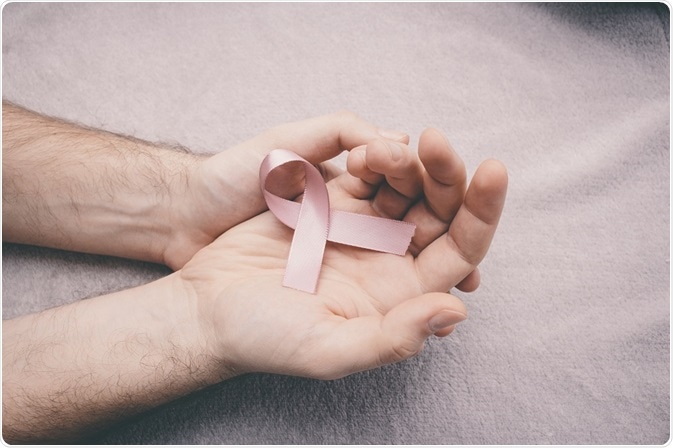The male breast is structurally and functionally different from female breast due to the hormones that guide its growth and maturity.
 Image Credit: marstockphoto / Shutterstock
Image Credit: marstockphoto / Shutterstock
Anatomy of the breast
The normal male or female breast has:
- Lobules (milk-producing glands)
- Ducts (tiny tubes that carry the milk from the lobules to the nipple)
- Stroma (fatty tissue and connective tissue surrounding the ducts and lobules
- tiny blood vessels, and lymphatic vessels
- The nipple where the ducts come together and a darkened area around it called the areola
Breast during puberty
Until puberty, young boys and girls have a small amount of breast tissue consisting of a few ducts located under the nipple and areola (dark area around the nipple).
At puberty, the female hormones in girls cause the breast ducts to grow, lobules to form at the ends of ducts, and the amount of stroma to increase. In boys, male hormones made by the testicles keep breast tissue from growing as much as females. Men's breast tissue has ducts, but only a few if any lobules.
Most common symptom of male breast cancer
The most common symptom of male breast cancer is development of a hard, painless lump over one of the breasts or clear or bloody discharge from one of the nipples. The shape of the affected breast and the nipple may differ from the other.
Male Breast Cancer Symptoms and Treatment | Dana-Farber Cancer Institute
Symptoms of male breast cancer
Symptoms of male breast cancer may be outlined as:
- Firm mass underneath the nipple
- The nipple may appear retracted to one side or underneath or depressed and there may be a discharge that is clear or bloody at the tip of the nipple
- There may be pain or itching at the nipple.
- There may be redness or scaling of the nipple or breast skin
- The mass itself is painless and may appear hard on touch
- The mass may be fixed to the underlying tissues, muscles and the ribcage or may be freely mobile on touch, slipping beneath the fingers.
- There may be dimpling or puckering of the skin if the mass is attached to the skin over the breast.
- Sometimes a breast cancer can spread to lymph nodes under the arm or around the collar bone and cause a lump or swelling there. This may occur even before the original tumor in the breast is large enough to be felt
- Very rarely gynaecomastia or enlargement of male breast may be seen. In patients with gynaecomastia the warning signs of breast cancer are swelling in one breast, hard or irregular breast tissue, rapid growth and recent onset, fixed mass and nipple or skin changes, pain, size over 5 cm in diameter and swelling of the lymph nodes in the armpits.
- General symptoms include weakness, fatigue, unexplained weight loss, anemia etc.
- In advanced cancers that have spread to other parts, other features include bone pain, shortness of breath, nausea, jaundice (if liver is involved) etc.
Male and female breast cancer compared
The male breast cancer is similar and different from female breast cancer in numerous ways.
Similarities and differences in male and female breast cancer include:
- Most of the risk factors for breast cancer in men are also seen in women.
- The signs and symptoms of the disease are the same in both sexes and the responses to treatment are similar.
- Survival from breast cancer is similar in men and women
- The same types of tumors seen in women are also seen in men
- The average age of diagnosis however is five to ten years later for men than for women.
- The number of estrogen receptor containing breast tumors (estrogen receptor positive tumors) in men is higher than in women
Further Reading